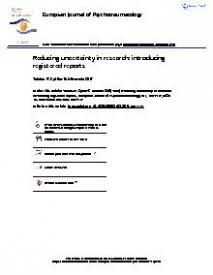Reducing uncertainty in research : introducing registered reports
On its website, the European Journal of Psychotraumatology (EJPT) states ‘The Journal shares ESTSS’s mission to advance and disseminate scientific knowledge about traumatic stress’ (European Journal of Psychotraumatology, 2018; www.tandfonline.com/ejpt). So far, this reads like the mission statement of almost every society’s academic journal. However, the EJPT differs from many other journals in how it approaches this goal. Most notably, the EJPT embraces a Gold Open Access policy since its foundation in 2010 (Olff, 2010, 2016).With the announcement to allow the submission of registered reports, the EJPT has taken a leading role in the field.
Accessibility
In today’s world, we expect clinicians and policy makers to take their decisions based on scientific evidence. Although in the internet age, information and knowledge appear to be at hand whenever needed, access to scientific knowledge is often not. The fact that almost half of all the scientific articles published in 2011 are behind a paywall (Van Noorden, 2013) illustrates this problem. For scientists it is crucial to have access to these articles and therefore their institutions pay significant subscription fees for journals in which these articles are being published. However, most people outside the scientific community, including clinicians and policy makers, especially in low- and middle-income countries, do not have free access to the knowledge they need. Instead, they have to buy single articles, which can be very costly.
All in all, this prevents many in need of scientific knowledge from accessing it. One solution for this problem is publishing scientific articles open access (OA). This means that an article is made freely available, usually via the internet. There are two models of open access publication. First, there are Gold Open Access journals, which publish all their articles open access. The cost for publishing the articles has to be paid by the authors or their funders. Second, there are traditional subscription journals who offer their authors the option to pay an extra fee to make their article freely accessible.
This second model is referred to as Hybrid or Green Open Access. In accordance with its mission statement, the EJPT falls in the former category, allowing free access to all its content. Over the last years, more and more researchers decided to publish their articles OA. With regard to psychotraumatology, the proportion of articles published as OA in 2017 varied greatly between countries (with more than 35% for authors from South Korea to less than 15% for authors from Israel; Olff, 2018).
From a macro perspective, the overall proportion of Gold OA publications in psychotraumatology increased from only a few percent at the beginning of the millennium to 17.7% of all articles published in 2017 (Olff, 2018). In the near future, the proportion of OA publications will likely continue to increase, maybe even faster than before. The underlying reason of this trend is that more and more funders release OA policies, requesting that research funded by them be published OA. Only recently a coalition of several national European funding agencies and the European Research Council announced their Plan S which restricts the target journals of research funded by them to Gold OA journals starting 1 January 2020 (cOALition S, 2018). This change in policy will likely result in dramatic changes in which journals psychotraumatology research can be published open access, given that, so far, the EJPT is the only Gold OA journal in the field (Olff, 2018).
In: European Journal of Psychotraumatology, ISSN 2000-8198 ; eISSN 2000-8066 | 9 | 1 | 1554417
https://doi.org/10.1080/20008198.2018.1554417


